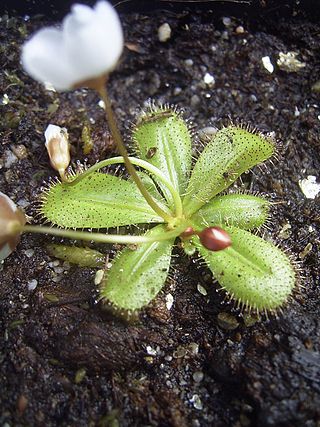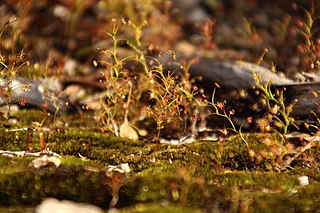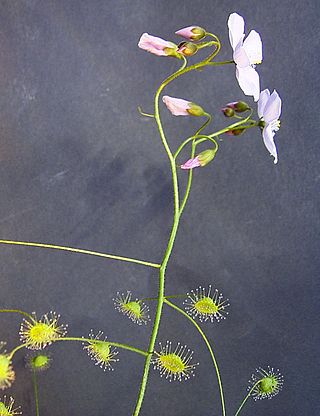
Drosera monticola is a perennial carnivorous plant species in the genus Drosera, the sundews. This species is endemic to a single mountain range in Western Australia.

Drosera tubaestylis is a perennial tuberous species in the genus Drosera that is endemic to Western Australia. It grows in a rosette about 2 to 3 cm in diameter. It is native to an area near Perth. It grows in fine sandy clay soils at the margins of swamps. It is considered to be related to D. bulbosa. The species is named for the trumpet-shaped style apices. It was first formally described by Allen Lowrie and N. G. Marchant in 1992.
Drosera orbiculata is a perennial tuberous species in the genus Drosera that is endemic to Western Australia. It grows in a rosette about 1.5 cm in diameter. It is native to an area 1.3 km north of Gillingarra near Perth. It grows in sandy clay soils in winter-wet depressions and washes. It is considered to be related to D. rosulata. The species is named for the shape of the leaf lamina. It was first formally described by Allen Lowrie and N. G. Marchant in 1992.
Drosera browniana is a perennial tuberous species in the genus Drosera that is endemic to Western Australia. It grows in a rosette about 3 to 4 cm in diameter. It is a common species in an area from Mount Holland to Hatters Hill along the greenstone belt northwest of Esperance. It grows in loam soils in wet zones near granite outcrops. It flowers from August to September. It is considered to be related to D. bulbosa. It was first formally described by Allen Lowrie and N. G. Marchant in 1992 and named in honour of Andrew Brown, who discovered this species' first population.

Drosera erythrorhiza, the red ink sundew, is a perennial tuberous species in the carnivorous plant genus Drosera that is endemic to Western Australia. It grows in a rosette and is distinguished from the other species in section Erythrorhiza by its many-flowered cymose inflorescences with up to 50 individual flowers. D. erythrorhiza was first described by John Lindley in his 1839 publication A sketch of the vegetation of the Swan River Colony. In 1992, N. G. Marchant and Allen Lowrie described three new subspecies, thus also creating the autonym D. erythrorhiza subsp. erythrorhiza. The subspecies were separated from this variable species mostly by leaf morphology and distribution.

Drosera bicolor is an erect perennial tuberous species in the genus Drosera that is endemic to Western Australia. It produces a basal rosette of leaves similar to that of D. peltata and the stem grows to 11 cm (4 in) high. Its white flowers that have a red spot near the petal base emerge from September to October. D. bicolor grows in deep silica sand on heathland along the upper Phillips River and south-east of Lake King.

Drosera erythrogyne is a scrambling or climbing perennial tuberous species in the genus Drosera that is endemic to Western Australia. It grows in soils that are peat-sand to loam and occurs in an area along the southern Western Australian coast west of Albany in swamps or near granite outcrops. It produces small leaves along a long, scrambling stem that can grow to 2–3 m (7–10 ft) long. White flowers emerge from August to October.

Drosera gigantea, the giant sundew, is an erect perennial tuberous species in the carnivorous plant genus Drosera that is endemic to Western Australia. It grows in sandy soils at the margins of swamps and near granite outcrops along the Western Australian coast from Albany north to just south of Geraldton. D. gigantea produces small shield-shaped leaves along many lateral branches that look like a small tree. Individual plants can grow up to 0.2–1 m (0.7–3.3 ft) tall. Because of its tall, tree-like form, it is considered one of the largest Drosera species. It is also easily cultivated and enjoys damp, humid conditions often provided in greenhouses. White flowers emerge from August to November. The red tubers of this species can grow to be 3.8 cm (1.5 in) in diameter and may be a metre below ground.

Drosera macrantha, the bridal rainbow, is a scrambling or climbing perennial tuberous species in the carnivorous plant genus Drosera that is endemic to Western Australia. It grows in a variety of habitats, including winter-wet depressions in sandy, loamy, laterite, or quartzite soils. D. macrantha produces small, cup-shaped carnivorous leaves along a long stem that can be 0.16–1.5 m (0.5–4.9 ft) high as it climbs. Its 1 in (2.5 cm) white or pink flowers emerge from June to November, blooming earlier in the more northern range.
Drosera marchantii is an erect perennial tuberous species in the carnivorous plant genus Drosera. It is endemic to Western Australia and grows in a variety of habitats, including swampy areas and hilltops in laterite-silica sand soils. D. marchantii produces small, circular, peltate carnivorous leaves along stiff stems that can be 10–40 cm (4–16 in) high. Its pink flowers emerge from June to October.

Drosera menziesii, the pink rainbow, is an erect or scrambling perennial tuberous species in the carnivorous plant genus Drosera. It is endemic to Western Australia and grows in a variety of habitats, including winter-wet depressions, swamps, and granite outcrops in clay or peat sand soils or loam. D. menziesii produces small, circular carnivorous leaves along an undulating erect stem that can be .05–1.1 m (0.2–3.6 ft) high. Its pink flowers emerge from July to November.
Drosera moorei is a scrambling or climbing perennial tuberous species in the carnivorous plant genus Drosera. It is endemic to Western Australia and grows near granite outcrops in sandy loam. D. moorei produces small, circular, peltate carnivorous leaves along glabrous stems that can be 12–35 cm (5–14 in) long. Inflorescences have two to ten yellow flowers and bloom from September to October.
Drosera neesii, the jewel rainbow is an erect or twining perennial tuberous species in the carnivorous plant genus Drosera. It is endemic to Western Australia and grows near swamps or granite outcrops in sand, clay, or laterite. D. neesii produces small, cup-shaped carnivorous leaves in groups of three along stems that can be 15–60 cm (6–24 in) high. Pink flowers bloom from August to December.

Drosera radicans is an erect perennial tuberous species in the carnivorous plant genus Drosera. It is endemic to Western Australia and is only found in a relatively small area north of Geraldton. It grows in winter-wet areas in sand or sandy clay soils. D. radicans produces small carnivorous leaves along stems that can be 7–18 cm (3–7 in) high. White flowers bloom from August to September.

Drosera stricticaulis, the erect sundew, is an erect perennial tuberous species in the carnivorous plant genus Drosera. It is endemic to Western Australia and is found near watercourses and granite outcrops in sandy clay or loam. D. stricticaulis produces small, cup-shaped carnivorous leaves along green, glandular stems that can be 25 cm (10 in) high. Pink flowers bloom from July to October.
Drosera subhirtella, the sunny rainbow, is a scrambling or climbing perennial tuberous species in the carnivorous plant genus Drosera. It is endemic to Western Australia and is found in sandplains, granite outcrops, and swamp margins in sand, clay, and loam soils. D. subhirtella produces small carnivorous leaves along stems that can be 40 cm (16 in) high. Yellow flowers bloom from August to October.
Drosera subtilis is an erect annual species in the carnivorous plant genus Drosera. It is native to northern Western Australia and a single site in the Northern Territory. In Western Australia, it has been collected from Beverley Springs Station, Bigge Island, and the Mitchell Plateau area all in the vicinity of the Kimberley region. In the Northern Territory, it has been found near Little Nourlangie Rock. It grows over sandstone near seepage margins in skeletal sandstone sand and black humus mixed soils. D. subtilis is anchored to the soil by a system of thin, fleshy roots and it lacks a tuber. It produces small carnivorous leaves along erect, reddish stems that can be 20 cm (8 in) high.
Drosera sulphurea, the sulphur-flowered sundew, is a scrambling perennial tuberous species in the carnivorous plant genus Drosera. It is endemic to Western Australia and is found in coastal areas in sandy loam, often among Cephalotus. D. sulphurea produces small, shield-shaped carnivorous leaves along stems that can be 40–60 cm (16–24 in) high. Yellow flowers bloom in September.
Drosera zigzagia is an erect perennial tuberous species in the carnivorous plant genus Drosera. It is endemic to Western Australia and is found on the margins of salt lakes in brown sandy loam, often associated with D. salina, Stylidium insensitivum, S. pulviniforme, Levenhookia leptantha, and Frankenia species. Drosera zigzagia produces small, solitary carnivorous leaves that alternate along a zigzag stem, which can be 5–7 cm (2.0–2.8 in) high. Yellow flowers are borne on 4–9-flowered inflorescences that bloom from August to September.

Drosera sect. Ergaleium is a section of 26 species that are erect or scrambling tuberous plants in the genus Drosera. This section represents a natural group and are taxonomically monophyletic.











